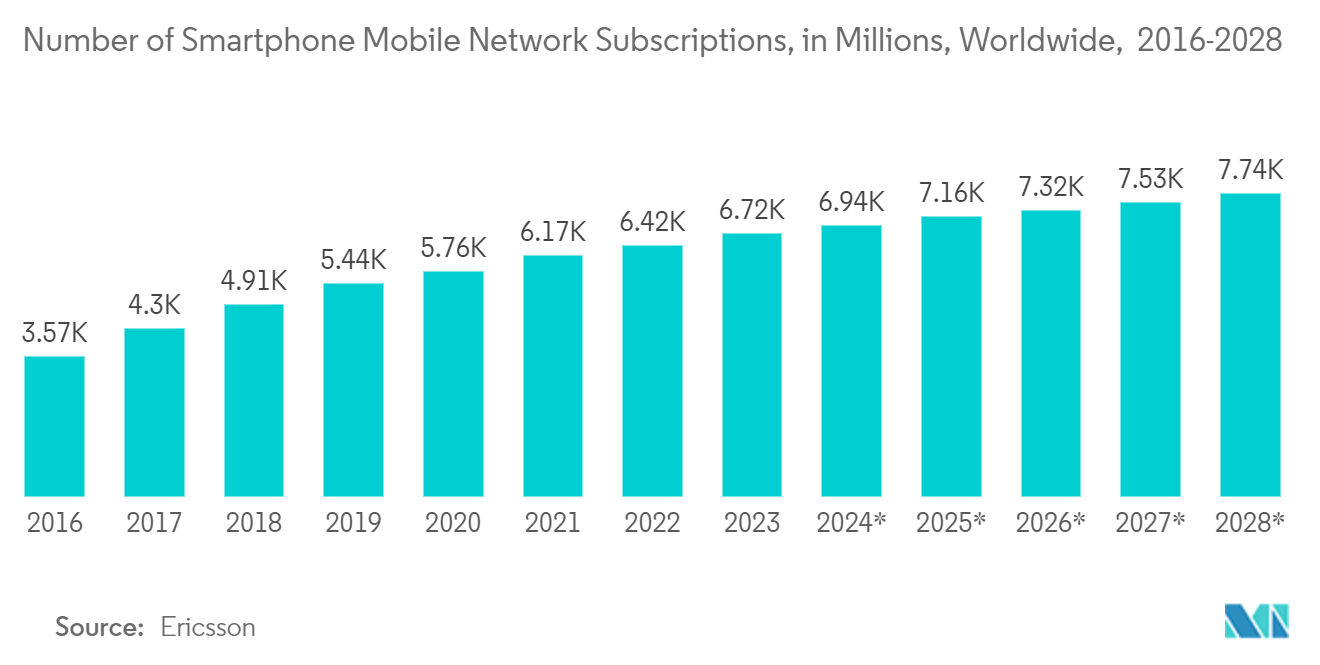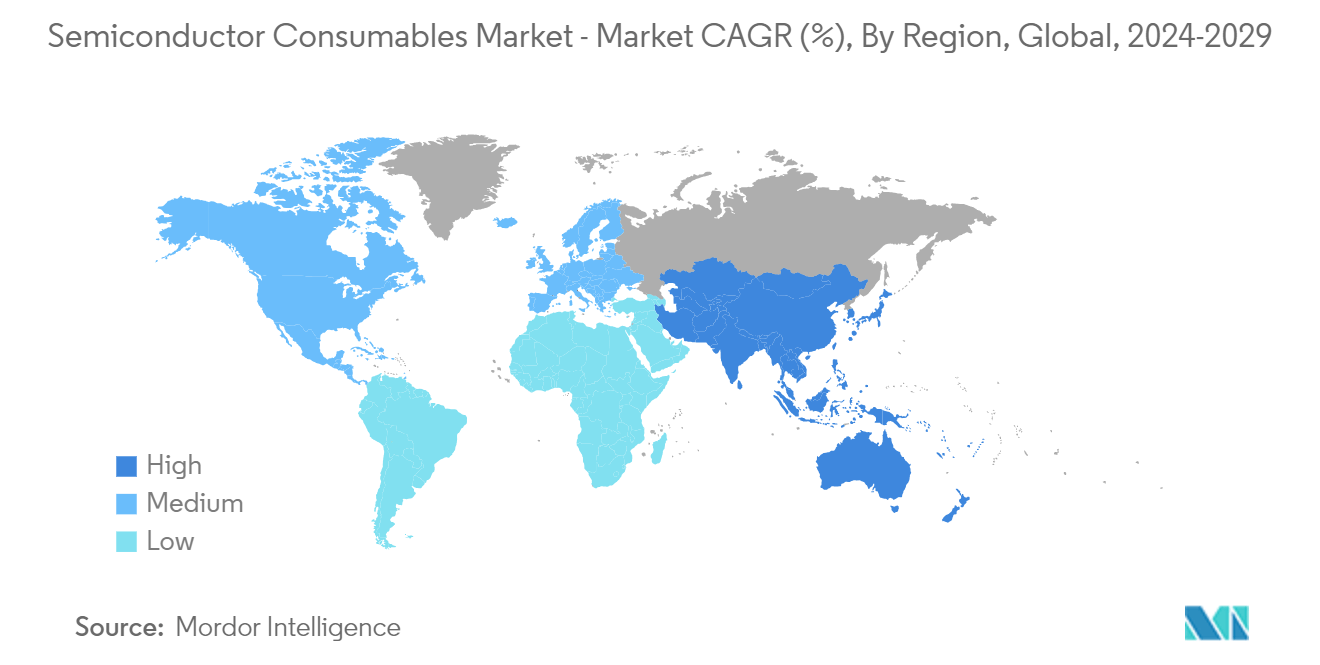Market Trends of Semiconductor Consumables Industry
The Wet Chemicals Segment is Expected to Drive the Market's Growth
- Semiconductor technology relies heavily on the precise manipulation and fabrication of semiconductor materials. One critical aspect of semiconductor manufacturing is the use of wet chemicals in various consumables. These chemicals are important in cleaning, etching, and passivating semiconductor surfaces, ensuring high-quality, defect-free devices.
- Wet chemicals are extensively used in the cleaning processes of semiconductor manufacturing. Semiconductor wafers, the primary substrates for chip production, often have impurities, contaminants, and residue from previous processing steps. Wet chemical cleaning removes these impurities and ensures a pristine starting point for subsequent fabrication steps. Different chemicals, such as sulfuric acid, hydrogen peroxide, and deionized water, are used to remove specific types of contaminants.
- Etching is an essential step in semiconductor manufacturing, used to remove layers of material from the wafer surface selectively. Wet etching involves using chemicals that can selectively dissolve specific materials without affecting others. For instance, hydrofluoric acid is commonly used to etch silicon dioxide, while other chemicals like potassium hydroxide or nitric acid are used for different materials. Precise control of the etching process is essential to achieve desired device structures and dimensions.
- Proper chemical waste management becomes critical with the increasing use of wet chemicals in semiconductor manufacturing. The disposal of spent chemicals requires adherence to strict environmental regulations to minimize ecological impact. Recycling and treatment processes are employed to recover valuable components from the waste, reducing environmental harm and overall production costs.
- The demand for semiconductors has been on the rise, driven by various factors such as robust growth in consumer electronics, computing, 5G, and automotive semiconductors. This increased demand for semiconductors directly translates into a higher demand for wet chemicals used in their manufacturing processes.
- According to Ericsson Mobility Report 2023, between the end of 2023 and 2029, global 5G subscriptions are forecasted to increase by over 330%, from 1.6 billion to 5.3 billion. 5G coverage was forecasted to be available to more than 45% of the global population by the end of 2023 and 85% by the end of 2029. North America and the Gulf Cooperation Council are anticipated to have the highest regional 5G penetration rates by the end of 2029 at 92%. Western Europe is forecasted to follow at 85% penetration.
- Moreover, according to Ericsson, the global number of smartphone mobile network subscriptions reached nearly 6.6 billion in 2022, and it is expected to exceed 7.8 billion by 2028. This is expected to drive the market studied further.

Asia-Pacific is Expected to Witness a High Market Growth Rate
- Taiwan plays a crucial role in semiconductor manufacturing in Asia-Pacific. Taiwan's semiconductor industry owes much of its success to the proactive role played by the government. The Taiwanese government has implemented a diverse range of policies and initiatives to foster the growth of the industry.
- One such initiative is the Industrial Upgrading and Transformation Plan, which aims to enhance the competitiveness of Taiwan's semiconductor industry through investments in research and development, talent acquisition, and infrastructure development. The government has also provided tax incentives, subsidies, and funding support to domestic semiconductor companies, encouraging them to invest in innovation and expand their global reach.
- Taiwanese semiconductor companies have continuously innovated advanced products and processes in the semiconductor consumables market, driving technological advancements in the industry. Advanced chip manufacturing technologies, such as 7 nm and 5 nm processes, have been successfully developed and deployed by Taiwanese firms, facilitating the production of smaller, faster, and more energy-efficient chips. The ability to manufacture these advanced semiconductors has given Taiwan a competitive edge in the global market.
- Additionally, the industry has witnessed substantial progress in the development of specialized chips for emerging technologies like artificial intelligence, the Internet of Things (IoT), and autonomous vehicles, which are further driving the growth of Taiwanese semiconductor consumables vendors.
- Taiwanese companies, such as TSMC (Taiwan Semiconductor Manufacturing Company), MediaTek, and UMC (United Microelectronics Corporation), have become critical players in the global semiconductor supply chain. TSMC, in particular, has emerged as one of the world's largest contract chipmakers, catering to prominent global technology companies.
- The presence of major semiconductor companies is likely to aid the expansion of the market studied in the country. Moreover, Taiwan's semiconductor industry has leveraged its robust supply chain to gain a competitive advantage. The country has developed a vertically integrated ecosystem, encompassing everything from design and manufacturing to testing and packaging. This integration allows for greater flexibility and cost-effectiveness, making Taiwan an attractive destination for semiconductor companies worldwide.
- The increasing electronics production and demand in Asia-Pacific are likely to drive the growth of the market studied. For instance, China is one of the prominent consumer electronics producers worldwide. The manufacturing industry is growing quickly in the country and is witnessing the deployment of several manufacturing and telecommunications technologies, which is likely to aid in the market's growth.


